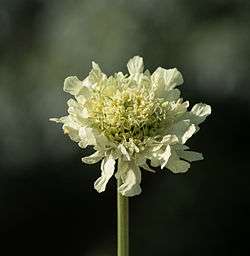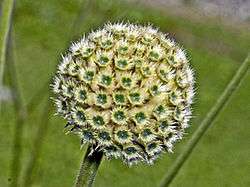Cephalaria alpina
| Cephalaria alpina | |
|---|---|
 | |
| Cephalaria alpina | |
 | |
| Inflorescence of Cephalaria alpina at the Paradisia Alpine Botanical Garden | |
| Scientific classification | |
| Kingdom: | Plantae |
| (unranked): | Angiosperms |
| (unranked): | Eudicots |
| (unranked): | Asterids |
| Order: | Dipsacales |
| Family: | Caprifoliaceae |
| Genus: | Cephalaria |
| Species: | C. alpina |
| Binomial name | |
| Cephalaria alpina (L.) Roem. & Schult. | |
| Synonyms[1] | |
| |
Cephalaria alpina, commonly known as the yellow cephalaria, alpine scabious[2] or yellow scabious, is a species of flowering plant in the family Caprifoliaceae native to the Alps in Europe.
Description
Cephalaria alpina is a branched, perennial herbaceous plant growing to 60–100 centimetres (24–39 in) in height. The long stem is hairy, leaves are 9–12 millimetres (0.35–0.47 in) long and 2–3 millimetres (0.079–0.118 in) wide, petiolate, dentate and densely hairy on the underside. This plant shows pale yellow head-like inflorescences on the naked stems. The flowering period extends from June to August. [3]
Distribution and habitat
This species is present in Western and Eastern Alps, in the northern Apennines and in the Swiss Jura. It prefers nutrient-rich and limestone soils at an elevation of 1,000–1,500 metres (3,300–4,900 ft) above sea level. [3][4]
It has been declared a weed in Australia.[5]
Ecology
The flowers are visited by the white-tailed bumblebee (Bombus lucorum) and Bombus cryptarum.[6]
References
- ↑ The Plant List: A Working List of All Plant Species, retrieved 15 May 2016
- ↑ USDA GRIN Taxonomy, retrieved 15 May 2016
- 1 2 Flora.nhm
- ↑ Schede di botanica
- ↑ Randall, R.P. (2007). The introduced flora of Australia and its weed status (PDF). CRC for Australian Weed Management. p. 109. ISBN 978-1-920932-60-2.
- ↑ Ozbek, Hikmet (1997). "Bumblebees fauna of Turkey with distribution maps Part 1: Alpigenibombus Skorikov, Bombias Robertson Bombus Latreille" (PDF). 21 (1): 37–56.
Bibliography
- Gunter Steinbach (Hrsg.): Alpenblumen (Steinbachs Naturführer). Mosaik Verlag GmbH, München 1996, ISBN 3-576-10558-1.
- Pignatti S. 1982 -Flora d'Italia. Bologna
- Zangheri P. 1976- Flora Italica. Padova
- Aeschimann D., Lauber K., Moser D.M., Theurillat J.P.,2004 - Flora Alpina. Bologna
- Conti F.,Abbate G.,Alessandrini A.,Blasi C., 2005 -An Annoted Checklist of the Italian Vascular Flora. Roma